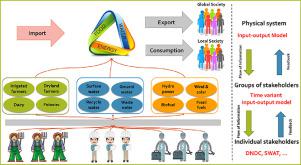Resources, Conservation and Recycling ( IF 13.2 ) Pub Date : 2020-11-09 , DOI: 10.1016/j.resconrec.2020.105267 Seyed Mohammad Hossein Tabatabaie , Ganti S. Murthy

|
With growing populations and changing climate, the food, energy and water (FEW) security have become a global issue. In response, the concept of FEW nexus in which the interdependency between FEW sectors are taken into account in order to effectively manage the resources and provide FEW security has emerged. Thus, in order to understand the interdependency between FEW sectors a thorough quantitative framework is necessary. Although there are numerous studies on FEW nexus, there is limited research on developing mathematical equations to model the FEW nexus. The goal of this study was to develop an input-output (IO) model to quantify the interdependency between FEW sectors in the Pacific Northwest. The FEW sectors were divided into 21 subsectors and IO model was used to quantify the total output of each subsector. Intensity coefficients were calculated and further broken down to technology coefficients and allocation coefficients. The uncertainty analysis was used to quantify the effect of variation in technology coefficients and allocation coefficients on output of each subsector and the results showed that these two distributions are significantly different. The results of sensitivity analysis showed that agricultural crops, especially alfalfa has the highest sensitivity to water and energy consumption due to the fact that alfalfa production is energy and water intensive. The multi-objective optimization was used to minimize the cost and environmental impact of FEW system and the results showed that in order to minimize the cost and environmental impacts, more surface water and hydroelectricity and wind electricity should be utilized.
中文翻译:

美国西北太平洋地区食品-能源-水关系的投入产出模型的建立
随着人口的增长和气候的变化,粮食,能源和水的安全已成为全球性问题。作为回应,出现了FEW关系的概念,其中考虑了FEW部门之间的相互依赖性,以便有效地管理资源并提供FEW安全。因此,为了了解FEW部门之间的相互依赖性,有必要建立一个全面的定量框架。尽管关于FEW关联的研究很多,但在开发数学方程以建模FEW关联方面的研究有限。这项研究的目的是建立一个投入产出(IO)模型,以量化西北太平洋地区FEW部门之间的相互依赖性。FEW部门分为21个子部门,并使用IO模型来量化每个子部门的总产出。计算强度系数,然后进一步细分为技术系数和分配系数。不确定性分析用于量化技术系数和分配系数变化对每个子行业输出的影响,结果表明这两个分布存在显着差异。敏感性分析的结果表明,由于苜蓿的生产需要大量的能源和水,因此农作物,特别是苜蓿对水和能源消耗的敏感性最高。多目标优化用于最小化FEW系统的成本和环境影响,结果表明,为了最小化成本和环境影响,应利用更多的地表水,水力发电和风力发电。


























 京公网安备 11010802027423号
京公网安备 11010802027423号